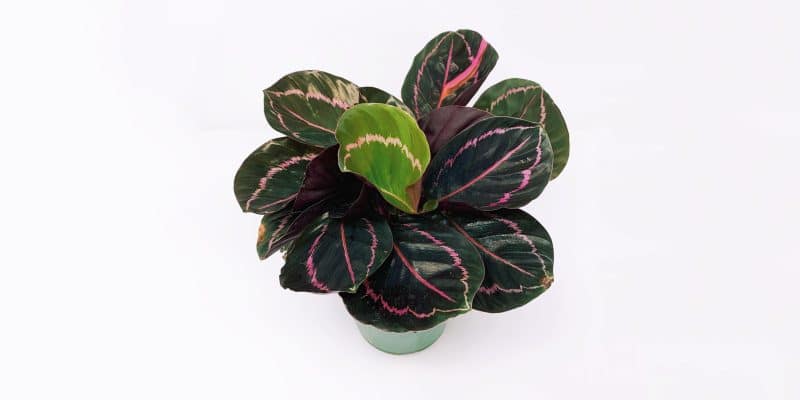Dear plant lovers, have we got a stunner for you today: Calathea Dottie.
A member of the prayer plant family that practically oozes drama, the Calathea Dottie features dark, almost black leaves and vibrant pink veins. And the best part? You don’t need to be a horticulturist to care for this tropical plant.
In this guide, we’ll explore everything you need to know to grow Calathea Dottie indoors, from its care requirements, propagation, and how to deal with some of the most common issues that might crop up.
Table of Contents
Calathea Dottie Plant Care Guide
History, Habitat, and Characteristics
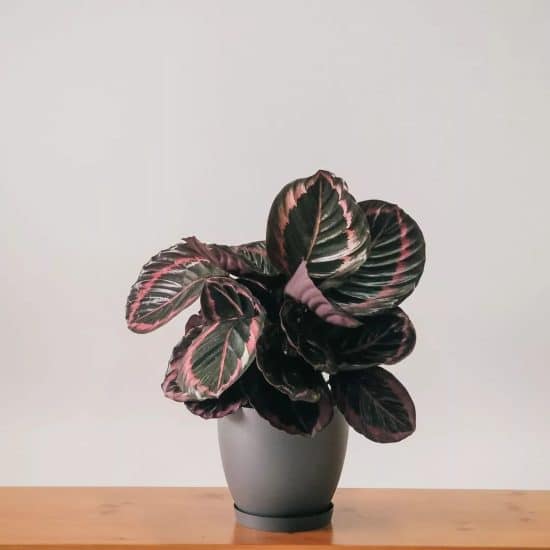
Calathea Dottie (Calathea roseopicta ‘Dottie’) hails from Brazil, Columbia, Ecuador, and Peru. It’s part of the Marantaceae family, more commonly known as the “prayer plant” family — and for good reason! Its leaves curl up at night as if in prayer and unfold gracefully with the sunrise.
This heliotropic behavior, also common in other Calathea species, is known as nyctinasty, where the leaves move in response to changes in light. This unique adaptation allows them to soak up the sun in their native tropical rainforest habitats, where light is often scarce under the dense canopy.
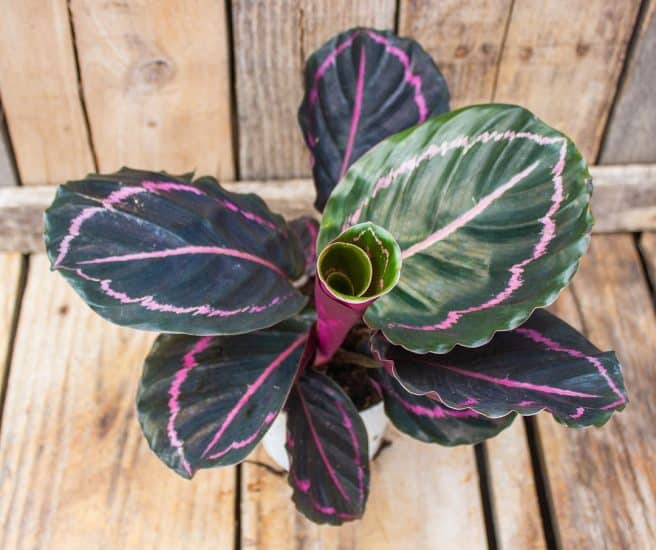
Calathea plants are masters of transformation. As the leaves mature, they turn from a light-green shade to an almost black hue. The mature Calathea Dottie’s dark leaves, adorned with vivid pink and purple patterns, set it apart from its botanical brethren. The rich maroon color on the underside of the leaves adds an extra touch of elegance.
Once rare in the United States, Calathea Dottie has since become more widely available for plant lovers to enjoy. When in bloom, it produces dainty flowers that resemble little irises — a delicate delight for the eyes — though it’s unlikely to bloom indoors.
Just a heads up: Calathea Dottie can be a bit of a diva when it comes to care requirements. However, if you’re willing to meet its needs, it will reward you with its extraordinary beauty and mesmerizing leaf movement.
Light
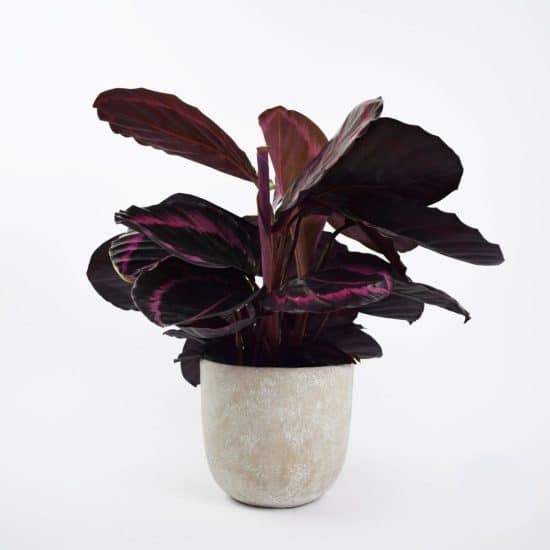
Calathea Dottie thrives best in medium to low indirect light, preferring shaded areas that mimic the protection it would receive from direct sunlight under the canopy of larger plants and trees in the wild. This kind of light is best provided by a north- or east-facing window.
Signs that your calathea is receiving too much direct light include burnt-looking leaves, edges turning crispy and brown, and fading of the bright pink markings on its foliage. If a sunny window is the best spot you have available, use a sheer curtain to diffuse the bright light.
While Calathea Dottie can tolerate low indirect light indoors, it is possible to give it insufficient light. If it needs a slightly sunnier spot, you may notice slow growth. To remedy this, move your plant closer to a window that offers indirect light, or consider using an artificial grow light (we recommend full-spectrum LED) to simulate natural sunlight.
Water
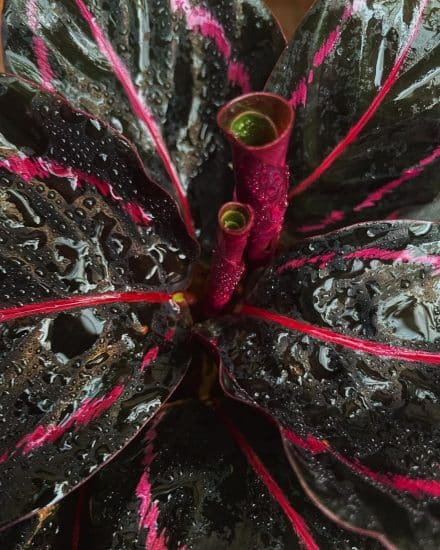
Calathea Dottie plants appreciate a consistent watering schedule. You should typically water your Calathea Dottie when the top 2 inches of soil have gone dry. Keep in mind that indoor plants don’t usually need to be watered as frequently as outdoor ones. You’ll want to use your fingers to feel if the soil is dry before watering.
Use filtered water or rainwater, since tap water contains chlorine and heavy minerals that can harm the plant. When watering Calathea Dottie, moisten the soil evenly and thoroughly, ensuring proper drainage. This helps maintain moisture levels without making the soil soggy, just the way Calathea Dottie likes it.
Signs your Calathea Dottie is not receiving enough water include drooping plant leaves and curling edges. Address these issues promptly to prevent further damage and help your plant bounce back.
Indications of too much water are yellowing leaves, mushy stems, and consistently moist soil. If you observe these symptoms, scale back on watering and let the soil dry out a bit before you water again.
Temperature and Humidity
As a tropical plant, Calathea Dottie favors a cozy, warm environment that’s not too hot. Aim for a comfortable range of 65-80°F (18-26°C). Avoid placing your plant near drafty windows, doors, or air conditioning vents that could cause the leaves to curl or produce brown spots.
When it comes to humidity, Calathea Dottie thrives in moist conditions. Strive for high humidity levels between 50% and 70% to keep your calathea plant content. Insufficient humidity can make the leaves curl and turn brown, while high humidity might lead to mold or fungus.
Be vigilant about your room’s humidity, particularly during drier seasons or winter months, when central heating causes the air in the home to dry out.
To raise humidity:
- Use a pebble tray filled with water to increase humidity around your Calathea Dottie.
- Position a humidifier close to your calathea plant to maintain consistent moisture levels.
- Combine your Calathea Dottie with other humidity-loving plants. Together, they’ll increase the local humidity through transpiration.
Soil and Planting
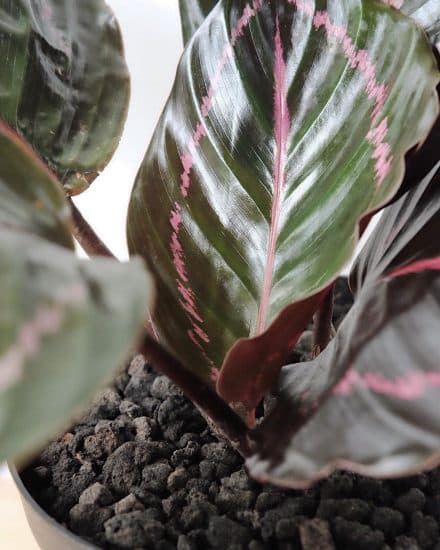
The ideal potting mix for Calathea Dottie includes:
- Pine bark
- Perlite or pumice
- Coconut coir
You can play with the proportions, but we recommend that half of your soil should be a regular potting mix.
Pine bark helps with moisture retention while preventing soil compaction. Perlite improves aeration and drainage, which protects the plant roots from overwatering.
Coco coir is an eco-friendly alternative to peat moss that also helps with moisture retention and aeration. Lastly, a well-draining potting soil provides essential nutrients for your plant’s growth.
Repotting
When it’s time to repot your Calathea Dottie, do so during the growing season. Check your Dottie’s root system to see if it’s ready for more space. You don’t want to repot a plant that isn’t ready, because excess soil in a pot that’s too big can lead to overwatering.
Choose a pot size slightly larger than the current one. Use a well-draining plastic or ceramic pot instead of a terracotta one. This will retain the moisture essential to healthy calathea plants.
Hot tip: If you’re worried about the potting mix seeping through the drainage hole, place an organic, unbleached coffee filter at the bottom of the pot. (Brilliant, eh?).
Fertilizing
Calathea plants, including the Dottie variety, don’t require much fertilizer, and too much can cause a buildup on the leaves. If you decide to use fertilizer, opt for an organic product in moderate proportions.
Keep an eye out for signs of over-fertilization, such as brown leaf tips and slow growth. In case this occurs, reduce the frequency and amount of fertilizer, and flush the soil with filtered water or rainwater to remove excess nutrients.
Propagation
Propagating a Calathea Dottie is an easy way to expand your collection, especially for beginner plant parents. The process primarily involves root division, which allows you to separate the creeping rhizomes that grow under the soil and encourage new shoots away from the mother plant.
Here are the steps to propagating your Calathea Dottie through root division:
- Gather your materials: First, you’ll need a clean, sharp pair of garden shears or scissors, the potting mix we described above, and one or more pots with drainage holes.
- Take the parent plant out of its pot: Gently pull the Calathea Dottie from its current pot by turning it upside down and easing it out with your hands. Be gentle so you don’t damage the roots, leaves, or stems.
- Find the rhizomes to divide: Now, examine the root system and spot the creeping rhizomes. These horizontal stems in the soil are where new growth emerges. Ensure the section you choose has at least one healthy growth point.
- Separate those rhizomes: With your shears or scissors, cut through the rhizomes to separate them from the main plant. You should now have a second, smaller plant with new growth, ready for replanting.
- Pot the divided rhizome: Fill the new pot with fresh, well-draining potting mix and place the divided rhizome in the center. Gently backfill with more potting mix and press the soil around the base of the plant.
- Water and show your new plant some love: Give the newly potted Calathea Dottie a good drink, allowing excess water to drain away. Put the pot in a warm spot with moderately bright indirect light, and care for it as you would a mature plant.
Common Issues
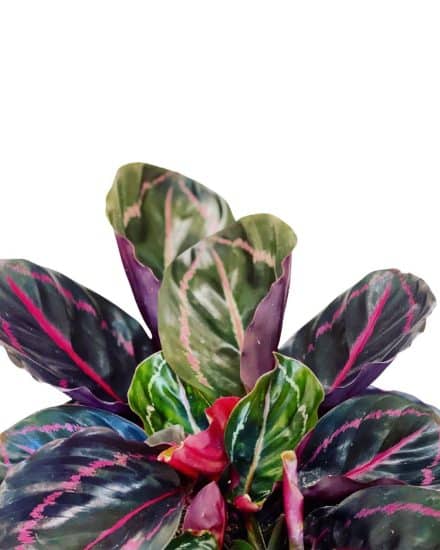
Calathea roseopicta ‘Dottie’ plants can be quite sensitive and demanding with their care. Keep an eye out for these common issues to ensure your Calathea Dottie flourishes.
Brown Crispy Leaf Tips
Brown leaf tips on your Calathea Dottie may be a result of watering with tap water, which often contains chlorine and heavy minerals, or applying too much fertilizer. This issue may also be caused by too much light.
To remedy these problems, switch to filtered water or rainwater, or reduce the amount of fertilizer you use, ideally choosing organic options. Make sure you don’t fertilize during the dormant winter months. This can lead to a buildup of fertilizer in the soil, which can ultimately overwhelm the plant.
Crispy tips and dried-out leaves are also a sign of insufficient humidity. Remove any dead leaves from your plant to focus its energy on the healthy leaves, and follow our tips for increasing humidity.
Dropping Leaves
While it can be concerning, leaf dropping in Calathea Dottie plants is natural. The plant might be directing more energy toward producing new healthy leaves, buds, and flowers, which can cause the outer leaves to droop.
However, excessive leaf dropping could be a sign of improper plant care, such as watering issues or a new environment unsuited to the plant’s needs.
To tackle this, ensure you’re providing adequate humidity by using a humidifier, placing a tray of water near the plant, or misting the leaves regularly. Additionally, be mindful of watering the plant when the top inch of soil feels dry, and avoid overwatering or underwatering, both of which are detrimental to your plant’s health.
Pests and Diseases
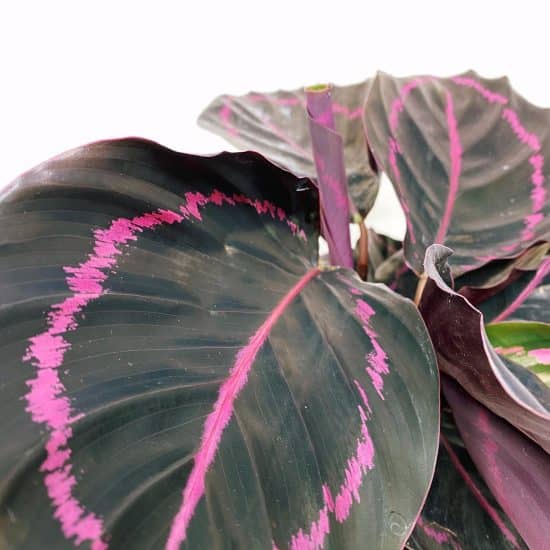
Calathea Dottie can sometimes experience pests, root rot, or fungus. Here’s how to spot and treat these problems right away.
Pests
Some common pests that may invade your Calathea Dottie include:
- Spider mites: Fine webbing around leaves and stems
- Mealybugs: Cotton-like coating appearing on leaves and stems
- Aphids: Small, pear-shaped insects that appear in a variety of colors
What to do? First, isolate the affected plant from others to avoid the pests spreading across all your houseplants. Use a damp cloth to gently wipe the leaves, removing visible pests. For more severe infestations, consider applying a natural insecticide like neem oil, and always follow the instructions on the label.
When you’re treating a plant with any kind of insecticide, whether biological or chemical, keep it away from direct light and any other sources of stress. This increases the chance that your plant will survive both the infestation and the treatment.
Root Rot
Root rot is a common problem among houseplants, including Calathea Dottie. When roots are soaked in excess water and soggy soil for extended periods, they;re deprived of oxygen. These anaerobic conditions lead to rotting of the roots and, eventually, plant death. Overwatering and poor drainage are the most common causes of root rot.
Signs of root rot include yellowing or wilting leaves and stems, a foul smell coming from the soil, and black or brown mushy roots. Here’s how to tackle root rot in a few simple steps:
- Gently remove the plant from its pot and examine the roots.
- With sterilized scissors, trim away any rotten roots (the slimy, dark, and mushy ones).
- Replace the old soil with fresh, well-draining potting mix (add perlite or pumice for extra aeration).
- Replant your Calathea Dottie in a pot with adequate drainage holes, and remember not to overwater in the future.
Conclusion
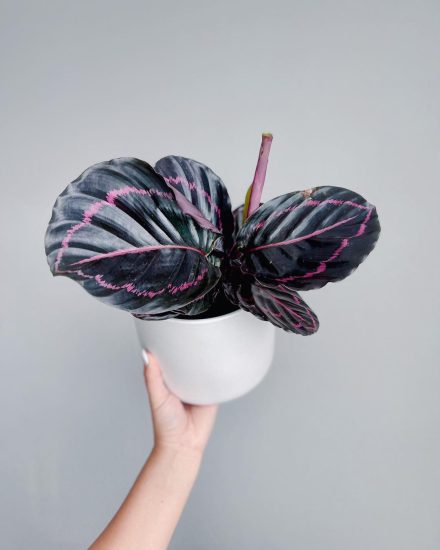
That’s a wrap for our Calathea Dottie care guide! We hope you’ve enjoyed learning about this mesmerizing plant and its unique nyctinastic behavior and dazzling foliage.
Calathea Dottie care summary:
- Provide medium to low indirect sunlight, mimicking its native rainforest habitat.
- Water with filtered or distilled water when the top 2 inches of soil are dry.
- Maintain temperatures between 65-80°F, and humidity levels between 50% and 70%.
- Use a well-draining potting soil.
- Fertilize sparingly with an organic product to avoid leaf damage.
- Repot during the growing season, and propagate through rhizome division.
Thanks for letting us guide you on your Calathea Dottie care journey. If you have any questions, don’t hesitate to get in touch. And if you found this guide useful, feel free to share it with fellow plant lovers!
Take care, and happy planting!
FAQ
Where do you put Calathea Dottie?
These plants thrive in spaces with indirect light. A room with north- or east-facing windows is a fantastic place to put your Calathea Dottie.
Be sure to keep the plant away from direct light, as well as drafty areas or air vents, which can stress out your plant.
Is Calathea Dottie an indoor plant?
Absolutely! Calathea Dottie is very adaptable to most indoor environments.
However, if you live in a warm, humid climate (USDA zones 10-12), Calathea roseopicta ‘Dottie’ can also be grown outdoors, but make sure it’s protected from direct sunlight and extreme temperatures.
Is Calathea Dottie toxic?
No. According to the ASPCA, Calathea Dottie is considered non-toxic to both cats and dogs, as well as humans. This means you can safely display your Calathea Dottie around the house without worrying about your furry friends or little ones.
Just remember to place them in areas where they won’t be accidentally knocked over or chewed on. Cats have been known to nibble on houseplants!
Is Calathea Dottie rare?
While Calathea Dottie might not be considered extremely rare, it’s definitely one of the more unique and sought-after varieties within the Calathea genus.
Its distinctive dark leaves with pink undersides and contrasting pink markings make it a favorite among houseplant lovers.

